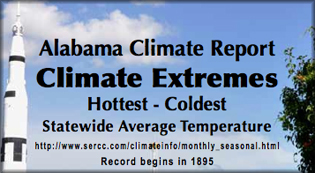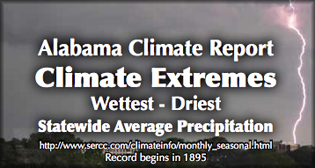Alabama experienced a notably active weather pattern throughout May. Significant weather events—including hail, high winds, and tornadoes—were reported on 17 of the 31 days. Fortunately, despite 23 reported tornadoes, there was only one injury and no fatalities. These frequent storms brought substantial rainfall—so much, in fact, that this May was the wettest May on record statewide.
For the first time since June & July of 2023, Alabama experienced back-to-back wetter than normal months. As noted earlier, this May was the wettest on record statewide, with 10.07 inches of rainfall—5.83 inches wetter than normal. As shown in Figure 1, the entire state was wetter than normal. A few notable long-term (100+ years) observing stations had their wettest May on record shown in Table 1. The highest monthly rainfall total was recorded at Crossville 2.2 NNE CoCoRaHS station with 18.23 inches, while the lowest was 4.76 inches at the Brewton 3 NNE station (which had no missing data). Notably, even the lowest total exceeded that station’s (Brewton 3 NNE) monthly average rainfall.
Temperature-wise, Alabama was warmer than normal, with a statewide average temperature of 71.9°F, which is 1.2°F above the long-term average of 70.7°F—ranking as the 42nd warmest May on record. The warmest temperature of the month was recorded at the Open Pond RAWS station and the Atmore COOP station, both reaching 95°F on the 26th and 28th, respectively. Conversely, during a brief cold snap from May 3rd to the 7th, the Ashland 5 SSW COOP station recorded the coldest temperature of the month at 41°F on the 5th.
At the beginning of May, about 7% of Alabama was experiencing abnormally dry conditions, primarily along the Mississippi border and in the tri-state area just north of the Florida Panhandle. A small area of moderate drought developed the following week in southeastern counties from Geneva to Henry. However, thanks to a record-setting wet month, all signs of drought were gone by the end of May.
While the rain eliminated drought concerns, it created new challenges for farmers. Wet conditions prevented many producers from planting their summer crops on time. Planting for cotton, peanuts, and soybeans was delayed across much of the state. Hay cuttings also fell behind schedule due to the lack of dry weather needed for cutting and baling. According to a report from the Alabama Cooperative Extension System, this will be the latest planted cotton crop in recent memory. In North Alabama, cotton farmers may still see normal yields from what they have managed to plant, but that progress largely depends on June weather, and anything planted after the first week of June may see a reduced yield potential of over 20%. Agronomic crop agents are now working closely with growers to develop cotton management plans in the hope that June brings enough favorable conditions to finish planting.
As we conclude the climatological spring (March, April, May), let’s review how Alabama fared this spring. Statewide, it was the 5th warmest spring on record, with an average temperature of 65.7°F, which is 2.8°F warmer than normal. From a precipitation standpoint, this spring was the 15th wettest on record, with 20.87 inches of precipitation, which is 5.66 inches wetter than normal. In terms of tornado activity, it was an active spring with 53 reported tornadoes—more than double the climatological spring average of 24. Interestingly, most of these occurred in March and May, not April, the climatological peak for tornadoes.
Monthly summaries are provided by Dr. Rob Junod, Lee Ellenburg and Dr. John Christy.
|














